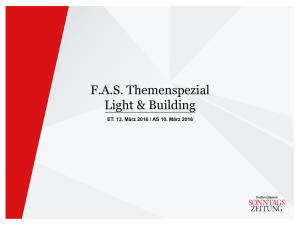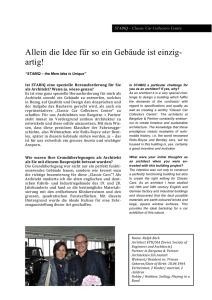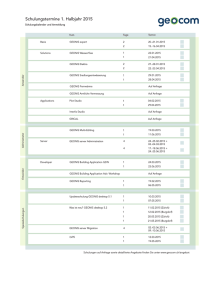ALUCOBOND® INTERNATIONAL
Werbung
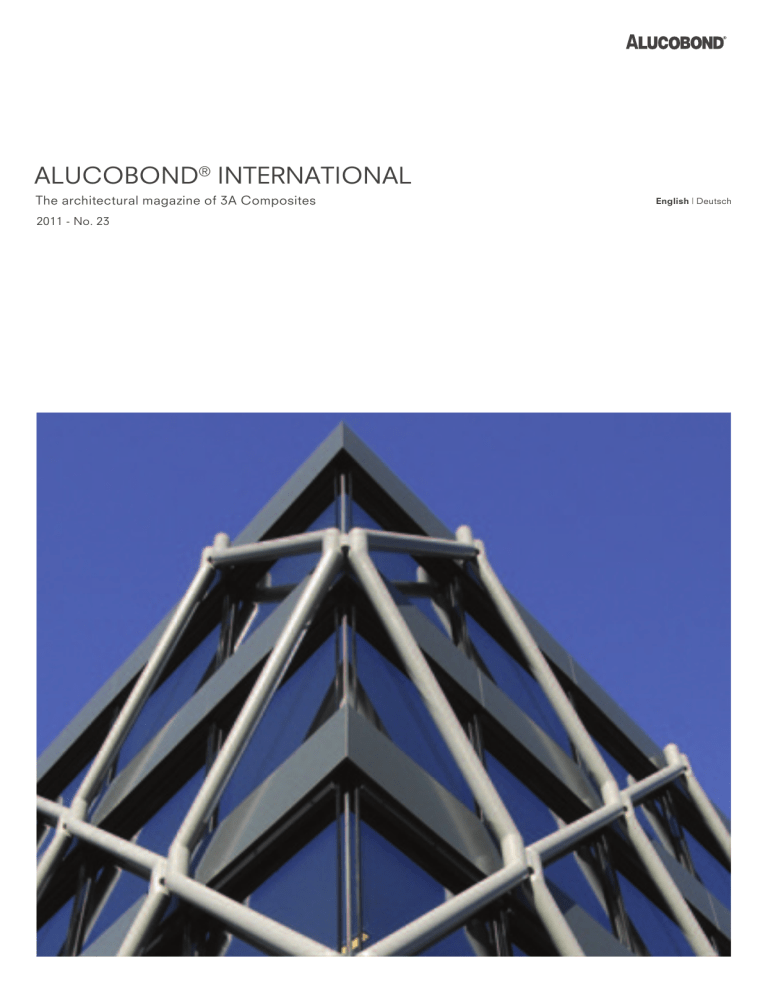
ALUCOBOND® INTERNATIONAL The architectural magazine of 3A Composites 2011 - No. 23 English | Deutsch content inhalt 04 A twisting skyscraper Ein gedrehter Wolkenkratzer 06 Additional dimension on the façade Fassade mit zusätzlicher Dimension 09 Modern spirit in historical style Moderne im historischen Stil 12 Iridiscent egg as promise to the future Irisierendes Ei als Zukunftsversprechen 15 From a waiting area to the figurehead Von der Warte zone zum Aushängeschild 18 From Lemons to Limes Aus Alt mach Neu 21 Exceptional free form in orange Aussergewöhnliche Freiform in orange 24 A sustainable and inspirational workplace Ein nachhaltiger, inspirierender Arbeitsplatz 27 Library in book format Bibliothek in Buchform 33 Subtle conversion of the company’s creed Subtile Umsetzung des Firmencredos 37 Red Bull Ring Spielberg Nomen est Omen 41 Pure elegance at the lake Schlichte Eleganz am See 44 Unusual façade with high functionality Ungewöhnliche Fassade mit hoher Funktionalität 48 Project information Projektinformationen 50 Imprint Impressum 2 3 A twisting skyscraper Ein gedrehter Wolkenkratzer Project: Office building Avaz “Twist Tower” Sarajevo Architect: ADS Studio Ahmet Kapidžić dia, Faruk Kapidžić dia INSTALLER / FABRICATOR: Mustafić d.o.o., Konjic Modern material combination of blue glass and metal Moderne Materialkombination aus blauem Glas und Metall The Balkan’s tallest tower, the Avaz Twist Tower, is located in Sarajevo’s recently renovated business district Marijin Dvor. After the country’s devastation by war, Bosnia is undergoing a true boom in the construction sector. Therefore it is ranking among the countries with the most construction going on in South East Europe. The Avaz Twist Tower designed by architect Faruk Kapidzic is the new headquarter of Avaz Media Group, the most popular Bosnia and Herzegovina newspaper company. The skyscraper stands out of its sourroundings with an overall height of 172 metres - 142 metres plus 30 metres for the spire. The special design of the structure makes it one of the most interesting towers in Europe. At an altitude of 100m the panorama-restaurant is floating, making its visit a breathtaking experience to every visitor. 4 The tower twists up to close to its peak where it cuts inwards almost giving it the appearance of a light house with aluminium coloured pillars. Clad in blue glass the design is broken up in places with silvery accents. It continues to be tiered to its peak almost making it look like a bride. Most of the tower is in hexagonal shape except the top two tiers which are rounded. The use of ALUCOBOND® extends from the basement of the building with its commercial and garage space over the entrance along the entire building ending with a cap on top of the tower. More than 7000 m² of ALUCOBOND® in Sunrise silver metallic and spectra titanium helped to create this masterpiece and convinced with ease of fabrication, installation and its aesthetic quality. The twisted skyskraper as a contrast to the traditional architecture Der gedrehte Wolkenkratzer steht im Kontrast zur traditionellen Architektur Der höchste Turm auf dem Balkan, der Avaz Twist Tower, liegt in Marijin Dvor, einem kürzlich renovierten Geschäftsviertel von Sarajevo. Nach den massiven Kriegsschäden erlebt Bosnien einen starken Boom in der Baubranche und wird so zu einem der bauintensivsten Länder in Südosteuropa. Der Avaz Twist Tower, entworfen vom Architekten Faruk Kapidzic, ist der neue Firmensitz der Avaz Media Gruppe, dem bekanntesten Zeitschriften-Unternehmen in Bosnien-Herzegowina. Der Wolkenkratzer ragt 172 Meter in den Himmel – 142 Meter plus 30 Meter Spitze – und ist einer der interessantesten Türme Europas. Das Panorama-Restaurant schwebt in einer Höhe von 100 Metern und stellt für jeden Besucher eine atemberaubende Erfahrung dar. Der Turm ist gedreht bis er an der Spitze in sich abschließt und so die Erscheinung eines Leuchtturms mit aluminium- farbigen Pfeilern hervorruft. Verkleidet mit blauem Glas, wird das Design stellenweise mit silbrigen Akzenten durchbrochen. Mit der Abstufung an der Spitze gleicht das Gebäude einer Braut. Bis auf die oberen beiden, runden Etagen dominiert die hexagonale Form. Der Einsatz von ALUCOBOND® erstreckt sich vom Gebäudesockel mit Garagen und Geschäftsflächen, über den Eingangsbereich entlang des gesamten Bauwerks nach oben und schließt in Form einer Haube ab. Mehr als 7000 m² ALUCOBOND® in Sunrise Silbermetallic und Spectra Titanium unterstützen die Wirkung dieses Meisterwerks und überzeugten zudem mit einfacher Verarbeitung, Installation sowie nicht zuletzt der ästhetischen Qualität der Aluminium-Verbundplatten. 5 Additional dimension on the façade Fassade mit zusätzlicher Dimension Project: Advice House at Lysholt Park (DK) Architect: C.F. Møller Architects INSTALLER / FABRICATOR: Signpartners A/S A glittering array of colours, light and shadows Ein schimmernder Anordnung von Farben, Licht und Schatten Advice House is the first completed building in the Lysholt Park, a new business-park north of Vejle, and is with its proximity to the motorway designated to act as landmark and eye-catcher for the entire development. Developed for Lysholt Erhverv A/S, the Advice House interior comprises 5,000 square meters of open and flexible office layout, where various tenants share the same large spaces, which offers different perspectives and angles. The building is shaped around two angled office wings, separated by an equally angled atrium, resulting in a plan resembling a hexagon, with one angle pushed inwards. The two wings, connected by walkways across the atrium, and the floors’ continuous window-bands give a high degree of freedom in the given plan. A large, north facing glazed gable gives passersby a glimpse of the 6 dynamic void, day or night, and the open and transparent interiors are also naturally ventilated. The façades of the building are colored and textured to catch the light. The cladding-strips are composed of a ‘random’ sequence of a total of 13 differently proportioned cladding panels, some of which are folded diagonally to create a triangulated pattern. The panels are mounted horizontally at staggered intervals, creating a glittering array of colors, light and shadows. The cladding panels are made from ALUCOBOND spectra® Cupral that offers changing color effects with highlights and interesting color gradients, depending on the viewing angle and the angle of the sun. Thus, the building never appears in quite the same way, and the effect is especially striking when passing by on the motorway. Connection of the two wings in the large atrium Verbindung der beiden Flügel im großen Atrium Advice House ist das erste fertiggestellte Gebäude im Lysholt Park, einem neuen Geschäftsdistrikt nördlich von Vejle. Mit seiner Nähe zur Autobahn ist es prädestiniert als Wahrzeichen und Blickfang des Geländes zu agieren. Entwickelt für Lysholt Erhverv A/S, umfasst das Advice House 5000 Quadratmeter Fläche mit einer offenen und flexiblen Aufteilung. Die Fläche ist gleichmäßig zwischen den ansässigen Unternehmen aufgeteilt. Auf diese Weise ergeben sich individuelle Perspektiven und Winkel. Das Gebäude formt sich um zwei abgewinkelte Flügel, die von einem gleichförmigen Atrium geteilt werden. Die Grundfläche ähnelt einem Hexagon, wobei ein Eckpunkt nach innen gekehrt ist. Die Verbindung der beiden Gebäudeflügel entsteht durch Brücken durch das Atrium. Die durchgängigen Fensterbänder verleihen dem gegebenen Plan die nötige Freiheit. Der große nach Nor- den ausgerichtete verglaste Giebel lässt Passanten bei Tageslicht oder in der Nacht einen flüchtigen Eindruck der vorherrschenden Dynamik erhaschen. Der offene, transparente Innenraum ist natürlich durchlüftet. Die Fassade fängt durch ihre Farbe und Struktur das Licht ein. Die verkleidenden Bänder folgen einer “zufälligen” Sequenz von insgesamt 13 unterschiedlich proportionierten Kassetten. Durch diagonale Abkantung formen einige ein trianguliertes Muster. In abgestuften Intervallen horizontal montiert kreieren die Kassetten ein funkelndes Spiel aus Farbe, Licht und Schatten. Die Pigmentierung der ALUCOBOND spectra® Platten erzeugt wechselnde Farbeffekte mit Glanzpunkten und interessanten Farbverläufen, abhängig von Betrachtungswinkel und Lichteinfall. Die Wirkung des Gebäudes variiert somit ständig, insbesondere beim Vorbeifahren auf der Autobahn. 7 Modern spirit in historical style Moderne im historischen Stil Project: The renovation and development of Renoma building by adding a new wing in the Czysty Square section Architect: Pracownia Projektowa Maćków from Wroclaw /Zbigniew Maćków, Piotr Krynicki, Marek Kotowski/ in collaboration with Maztech INSTALLER / FABRICATOR: MAZTECH Sp. z o.o. Array of colour, light and shades through the structured façade Spiel aus Farbe, Licht und Schatten durch die strukturierte Fassade Pictures: Julian Weyer, C.F. Møller Architects 8 The fan-shaped cornices create the strongly emphasized façade Die fächerartigen Gesimse verstärken die stark betonte Fassade RENOMA is a historical and exclusive department store built in 1930 as “Wertheim” Department Store, in the heart of Wroclaw. The concept comprises the renovation of the old ‘Wertheim’ department store and its extension in the eastern direction, which involves the new part located at Czysty square and Czysta street. The original design based on Herman Dernburg’s design was erected in 1929 at the intersection of Swidnicka and Podwale street. The main objective of the new design was to continue the style and form of the existing architecture and creating the building referring to the old department store with its elegant look and high standard. The consistency of the old and new parts was achieved by correct proportions, inscribing the new building into the historical urban structure, thanks to the horizontal divisions of the façades as well as the character of the materials and colours used. A dynamic nature of the horizontal façade of the new part was intensified by a fan-shaped deflection of cornices, which create a very strongly emphasized façade foreground. Its background is created by large windows and walls finished with dark-brown fibre-concrete cladding panels, corresponding to the ceramic facing of the antique edifice. The new building is connected with the antique edifice by an entrance atrium, which serves as a connecting element between the two parts. The design also involves the landscape design of The Czysty Square and the rebuilding of Podwale and Czysta streets, increasing the quality of the area surrounding the department store and re-engaging it with city life. 9 The old Wertheim store Das alte Wertheim Kaufhaus The new concept Das neue Konezpt The dynamic of the horizontal layout Die Dynamik der Horizontalausrichtung Fixing of the cornices Befestigung der Gesims Connection of new building and antique edifice by the glazed entrance atrium Verbindung des neuen zum historischen Gebäude durch ein gläsernes Atrium RENOMA ist ein historisches und exklusives Kaufhaus, das 1930 als “Wertheim” Kaufhaus inmitten von Breslau errichtet wurde. Das neue Konzept umfasst sowohl die Renovation des alten “Wertheim-Gebäudes” als auch seine Ausdehnung in östliche Richtung durch einen Neubau an Czysty Platz und Czysta-Strasse. Das historische Gebäude von Architekt Herman Dernburg wurde 1929 an der Kreuzung Schweidnitzerstrasse und Podwale Straße errichtet. Ziel der neuen Planung war, Stil und Form der bestehenden Architektur fortzuführen und an das alte Kaufhaus mit seinem eleganten Aussehen und hohen Standard anzupassen. Die Konsistenz von Alt- und Neubau wurde durch korrekte Proportionen erreicht. Der Neubau fügt sich durch die horizontale Fassadengliederung sowie Charakter und Farbe der verwendeten Materialien in das historische Stadtbild ein. Die Dynamik der Horizontalaus10 richtung der Neubaufassade wird durch fächerartig gebogene Gesimse verstärkt. Dahinter sind große Fensterflächen sowie mit dunkelbraunem Faserzement verkleidete Wände, die sich in ihrer Optik dem historischen Gebäude angleichen. Der neue Gebäudeteil schließt sich über ein Eingangsatrium an, welches als Verbindungselement fungiert. Das Design bezieht auch die stadtplanung von Czysty Square sowie von Podwale und Czysta Strasse mit ein. Dies wird die Qualität dex Stadtbereichs rund um den Kaufhauskomplex verbessern und mit neuem Leben füllen. 11 Iridiscent egg as promise to the future Irisierendes Ei als zukunftsVersprechen Project: Multi-purpose hall Cesbron, France Architect: Agence Bodreau Architecture Géraldine Jean INSTALLER / FABRICATOR: Tim Composites, France The egg seems to float on the water surface Das Ei scheint auf dem Wasser zu schwimmen Façade and water are reflecting each other Fassade und Wasser in wechselseitiger Spiegelung The new headquarters of the company group Cesbron is situated in the midst of nature in Saint Sylvain d’Anjou, near Angers. The main building arises next to a basin of 1800 m², where the futuristic ovoid seams to float. Both structures are connected with a vitreous tunnel. The stunning architecture plays with the contrast of the natural surroundings and the industrial activity of the group. The administrative building with a floor space of 2900 m² on three floors corresponds to its environment through the façade of larch wood. In contrast “the egg” conveys a high-tech look to the scenery. “The multi-purpose hall in form of an egg is placed on the specular water surface like a promise to the future”, explains the architect. “Its surface made of ALUCOBOND spectra® evokes the texture of a real egg, whereupon the water is reflected 12 in a mood of eternity.” The material is imbedding the oval smoothly and creates playful reflections of the daylight and calming impressions. the building’s three-dimensional form. Initally the architects considered the use of other materials as well, but only ALUCOBOND® could comply with all demands: a smooth surface, which The newly established water basin adapts perfectly to the structure and moisturizes the air and thus contrib- convinces with its aesthetic effect. utes to the cooling of the buildings south side. This is part of the climatic concept. After only 5 months of operation the energy balance is positive. With a strong insulation, heat pumps and modern photovoltaic the company is pointing the way towards energy saving and sustainability. Underneath the egg’s floor the whole air-conditioning technology is situated. The construction of the egg is consisting of a wooden substructure with a vapour trap and a four-ply insulation of mineral wool. The outer cladding of ALUCOBOND spectra® was cut in trapezoid forms and snuggles to Die neue Firmenzentrale der Gruppe Cesbron befindet sich auf einer Fläche von 5 Hektar inmitten der Natur in Saint Sylvain d’Anjou, nahe Angers. Das Hauptgebäude erhebt sich neben einem Bassin von 1800 m², in dem der futuristische, ovoide Mehrzwecksaal zu schwimmen scheint. Beide Körper sind durch einen gläsernen Tunnel miteinander verbunden. Die erstaunliche Architektur spielt mit dem Kontrast zwischen umgebender Natur und der industriellen Aktivität der Firmengruppe. Das Verwaltungsgebäude mit einer Fläche von 2900 m² verteilt auf drei Stockwerke fügt sich mit der Fassade aus Lärchenholz in die Umgebung ein. Demgegenüber verleiht „das Ei“ dem Gesamtgeschehen einen ausgefallenen High-Tech-Look. „Der Mehrzwecksaal in Eiform setzt sich mit seiner ungewöhnlichen Form wie ein Versprechen an die Zukunft auf die spiegelnde Wasseroberfläche“, so die Architektin. „Seine Oberfläche aus ALUCOBOND spectra® erinnert an die Textur eines echten Eis, wobei sich das Wasser darin in einem Gefühl der Unendlichkeit widerspiegelt.“ Das Material schließt das Oval geschmeidig ein und erzeugt spielerische Reflexionen des Tageslichts mit beruhigender Wirkung. Das neu angelegte Wasserbassin befeuchtet die Luft und trägt zur Kühlung der Gebäudesüdseite bei. Dies ist Teil des klimatischen Konzepts. So ist bereits 5 Monate nach der Inbetriebnahme die Energiebilanz positiv. Durch starke Isolierung, Wärmepumpen und moderner Photovoltaik setzt das Unternehmen ein klares Zeichen in Richtung Energieeinsparung und Nachhaltigkeit. Unterhalb des Fußbodens „des Eis“ ist die gesamte Klimatechnik untergebracht. Der Aufbau des Mehrzwecksaals besteht aus einer Holz-Unterkonstruktion mit Dampfsperre, auf die eine vierlagige Isolation aus Steinwolle aufgebracht wurde. Die Außenverkleidung aus ALUCOBOND spectra® wurde trapezförmig zugeschnitten und schmiegt sich dreidimensional an die Gebäudeform an. Wurden von den Architekten anfangs noch mehrere Materialien in Betracht gezogen, konnte doch nur ALUCOBOND® sämtliche Anforderungen erfüllen: eine glatte Oberfläche, die sich exakt der Gebäudestruktur anschmiegt und zudem noch mit seiner ästhetischen Wirkung überzeugt. 13 From a waiting area to the figurehead Von der Wartezone zum Aushängeschild Project: Busumsteigebahnhof Hamburg-Poppenbüttel, Germany Architect: Blunck-Morgen Architekten Hamburg mit WTM Ingenieure Hamburg und Martin Tamke INSTALLER / FABRICATOR: Brinkmann, Lemgo - Wittenauer GmbH, BVG Blechverformungsges. mbH, Germany The wing evokes the impression of a sail Der Flügel gleicht einem Segel Aluminium rails covered with plastic serve as fixation for the ALUCOBOND® panels. Aluminiumschienen, die mit Plastik umhüllt sind, dienen der Befestigung der ALUCOBOND®-Platten. Ventilation and bio-climatic treatment Belüftung und bio-klimatische Aufbereitung. 14 The new bus change station in Hamburg-Poppenbüttel is connecting the bus stops to the urban railway station and the park-and-ride deck with a central pedestrian bridge. With the centralized change station the headstone of the new structured, barrierfree traffic junction in Poppenbüttel was placed. The design concept was to erect a sculpture in the air. The surface of the floating roof with 1800 m² is the striking design element of the modern bus station and impresses with a light, almost flying look-and-feel. The ground floor consists of only few materials and flows underneath the wing, thus reinforcing the floating character of the roof. Steel columns bear the sail. The twofold bent cladding of ALUCOBOND® passes to the foil surface. The offices of Hamburg’s train authorities are situated underneath the winged roof: sanitary facilities, selling points and lounges for the passengers. Eight departure platforms are arranged around the island to be passed independently. The old bus station dated from 1973 only had limited capacities. This was the reason for the modernization. 50 years ago a number of 20 000 passengers were passing – today the number has tripled. The bus station has been upgraded from a waiting area with weather protection to a figurehead of traffic engineering and urban planning in the centre of Poppenbüttel. 15 A floating sculpture Eine schwebende Skulptur Der Neubau des Busumsteigebahnhofes Hamburg Poppenbüttel verbindet die Busanlagen über eine zentrale Fußgängerbrücke mit der S-Bahn Haltestelle und dem P+R-Parkhaus. Mit dem zentralen Umsteigebahnhof der Hamburger Hochbahn wurde der erste Baustein des neustrukturierten und barrierefrei ausgebauten Nahverkehrsknotenpunktes Poppenbüttel fertig gestellt. Das gestalterische Motiv war der Gedanke, eine Skulptur in der Luft zu bauen. Die 1800 Quadratmeter große Fläche des schwebenden Flügeldachs ist das markante Gestaltungselement des modernisierten Busbahnhofs und beeindruckt mit ihrer leichten, fast schwebenden Anmutung. Der mit nur wenigen Materialien umgesetzte Bodenbelag fließt gleichsam unter dem Flügel hindurch und verstärkt den schwebenden Charakter des Dachs. Das Segel wird von Stahlstützen getragen. An die doppelt gekrümmte Verkleidung aus ALUCOBOND® schließt 16 sich die Folienfläche an. Unter dem Mix aus Flügel- und Foliendach befinden sich Räumlichkeiten der Hamburger Hochbahn, Sanitärräume, Verkaufstellen, Aufenthaltsgelegenheiten für die Busfahrer und natürlich Wartezonen für die Fahrgäste. Acht Bussteige sind um die Insel so angeordnet, dass sie unabhängig voneinander anfahrbar sind. Die beschränkte Leistungsfähigkeit der alten Umsteigestelle aus dem Jahr 1973 war ausschlaggebend für die Modernisierung. Passierten vor knapp 50 Jahren noch 20.000 Fahrgäste am Tag Poppenbüttel, ist das Passagiervorkommen heute auf das Dreifache angestiegen. Der Busumsteigebahnhof wurde von der Wartezone mit Wetterschutz zum verkehrstechnischen und städtebaulichen Aushängeschild des Ortszentrums Poppenbüttel aufgewertet. A modern figurehead in the center of the city Ein modernes Aushängeschild im Stadtzentrum 17 From Lemons to Limes Aus alt mach neu Project: Modernisation of the housing estate Höxterstrasse 2 - 26, Hagen, Germany Architect: Stadtbildplanung Dortmund GmbH Andreas Hanke Architekt, Dortmund INSTALLER / FABRICATOR: Henke AG, Germany Decent and warm colours break the old monotony off Dezente und warme Farben machen der Monotonie ein Ende At the end of the 1960s all over Europe so called tower blocks had been erected nearby important cities. The main concept was to improve the transport network in order to reduce the traffic afflux towards the main cities. Until mid of the 1980s large housing blocks dominated the scene in the suburbs. Today the dull and grey surroundings generate a feeling of uncertainty and inactivity. Dirty, spoilt and inadequately signposted entry halls are a real hurdle for the inhabitants, who want to welcome family and friends. Parking grounds instead of children’s playgrounds are a dangerous and disturbing periphery. The architect Andreas Hanke was conscious about the social problems coming along with an obsolete and in no way contemporary architecture. With his projects he considered the wishes of the inhabitants. In Hagen, Höxterstraße the colours of the fa- 18 çades vary depending on the urban district or street. Based on the large colour range of ALUCOBOND® the architect has chosen the colours blue, white, yellow, light green and vibrant red in the whole complex. With the play of colours in the sunlight the renovated façades convey a subtle note of slowdown and recreation. The result is stunning. With the choice of decent and warm colour shades and the trendy design the whole complex leads to a coherent and harmonic atmosphere. The monotony is over! Furthermore children’s playgrounds and green areas were included. In order to emphasize the individuality of each building large housing numbers were place. They are visible from a distance and support the design with a playful note of modernity. The entry halls of the buildings remember the lobbies of luxury hotels or high-class spas. The complex is situated in a mountainous valley. Therefore the upper area of the façade was decorated with mountain themes printed directly on ALUCOBOND®. After the renovation all buildings are integrated in the natural surroundings adequately to the geographical location. The design concept is based on historic buildings Das Gestaltungskonzept basiert auf historischen Stadtansichten Überall in Europa entstanden Ende der 60er Jahre in der Nähe wichtiger Zentren sogenannte Wohnsilos. Das Grundkonzept beinhaltete einerseits die Entwicklung der Verkehrsnetze und andererseits eine Entlastung des Verkehrsaufkommens mit dem Ziel den großen Andrang auf die Großstädte zu verringern. Bis Mitte der 80er Jahre wuchsen in den Vororten breite und hohe Wohngebäude. Heute erzeugt die traurige und graue Umgebung ein Gefühl von Unsicherheit und Untätigkeit. Schmutzige, beschädigte und sehr schlecht ausgeschilderte Eingangshallen von Wohngebäuden sind ein wahres Hindernis für alle Einwohner, die gerne Verwandte und Freunde in aller Ruhe empfangen möchten. Parkplätze ersetzen bestehende Kinderspielplätze und erweisen sich als gefährlich und wenig beruhigend. Architekt Andreas Hanke, der sich aller sozialen Probleme bewusst ist, die eine überalterte und für unser zeitgenössisches Leben überholte Architektur mit sich bringt, hat mit seinen Projekten die Anliegen der betroffenen Einwohner berücksichtigt. In Hagen, Höxterstraße, beispielsweise, variieren die Farben der Fassaden je nach Stadtvierteln oder Straßen. Auf Basis der grossen Farbvielfalt von ALUCOBOND® hat Herr Hanke die Farbtöne blau, weiß, gelb, beige, zartes grün oder auch leuchtendes Rot in der gesamten Architektur angewendet. Mit dem Farbenspiel der Sonne auf den renovierten Fassaden verschafft ALUCOBOND® den Wohngebäuden eine subtile Note der Beruhigung und Erholung. Das Ergebnis ist verblüffend, mit der Auswahl an sehr dezenten und warmen Farbtönen und dem trendigen Design mündet der gesamte Gebäudekomplex in eine in sich stimmige und sehr harmonische Atmosphäre. Vorbei die Eintönigkeit! Darüber hinaus wurden speziell angel- egte Grünflächen und Kinderspielplätze eingerichtet. Um die Besonderheit der Gebäude hervorzuheben wurden an allen Eingängen riesige Hausnummern angebracht die von weitem sichtbar sind und der Umgebung eine spielerische Note der Modernität verleihen. Die Eingangsbereiche der Gebäude ähneln den Lobbys von Luxushotels oder erstklassigen Spas. Für den sich mitten in einem gebirgigen Tal befindlichen Gebäudekomplex wurde der obere Fassadenbereich unterhalb der Gebäudedächer mit Bergmotivbildern geschmückt, die direkt auf ALUCOBOND® gedruckt wurden. Nach Abschluss der Gebäudesanierungen fügen sich heute alle Wohngebäude passend zur geographischen Lage harmonisch und stimmig in die natürliche Umgebung ein. 19 Exceptional free form in orange AuSSergewöhnliche Freiform in orange Project: IT Fornebu, Old Airport Oslo, Norway Architect: A-Lab, Oslo, Norway INSTALLER / FABRICATOR: Franke Onsrud Blikkenslagerverksted AS Aerial View Luftansicht Every building has its own individual character Jedes Gebäude hat seinen eigenen individuellen Charakter The new Portal building in Fornebu, the former Oslo Airport is an extension to the old Airport Terminal building housing the Business and incubation centre for information technology companies; IT-Fornebu. In 1998 the Old Fornebu airport closed after 60 years of function. A platform of possibilities was left open for new fields of investment. Therefore it was required that the design of the Portal building would combine the vision of the new Fornebu Business centre and establish an efficient and flexible cluster of offices in the area. The design criteria’s were to reduce volume and waste, provide an effective, efficient and healthy workplace, enhance communications and give a flexible layout. The main concept was to strip and divide the program into independent architectonic elements, clearly defined by function, in order to gain maximal flexibility and distinct archi- 20 tectural identity. The project consists of four glazed office blocks, where light, views and acoustics are optimal, four stone clad supply towers and the public Hub covered in “mandarin red” ALUCOBOND®, lifted over the main entrance. The four office blocks have a rectangular and rational form. The structure is put outside the exterior façade. It is shaped as a diagonal steel structure around the block. All shared functions such as vertical communication, technical services and wet cores are placed in intermediate towers, detached from the working areas. The free-form orange Hub with its orange façade of ALUCOBOND® is an exception and has a clear identity, it acts as a strategic element that glues all the activities, highlights the synergy between the existing terminal building and the new It-Fornebu Portal building. 21 Schematic view of the old airport terminal in Fornebu and its extension Schematische Ansicht des alten Flughafenterminals in Fornebu und dessen Erweiterung The new portal building as the administrative hub in mandarin red ALUCOBOND®. Das neue Portalgebäude als zentrale Verwaltung in mandarinfarbenem ALUCOBOND®. Das Portalgebäude in Fornebu, Norwegens früherem Flughafen, ist eine Erweiterung des bestehenden Terminals und dient als Geschäftszentrum für Unternehmen im Bereich der Informations- Technologie: IT-Fornebu. Als 1998 der alte Flughafen nach 60 Jahren Betrieb geschlossen wurde, bot das Gelände Raum für neue Geschäftsfelder. Das Eingangsgebäude sollte daher auch die Vision des neuen Geschäftszentrums verkörpern und ein effizientes und flexibles Cluster für Büroräume bieten. Die Konzeptanforderungen waren klar: optimale Platzausnutzung, Schaffung von effektiven und für die Gesundheit optimalen Arbeitsplätzen, Verbesserung der Kommunikationsstruktur und all dies mit einem flexiblen Layout. Der Raum wurde in unabhängige Elemente gegliedert, deren Architektur durch ihre Funktion bestimmt ist. So konnten maximale Flexibilität und klar abgesetzte, architektonische Iden22 tität geschaffen werden. Vier verglaste Büroblöcke mit optimaler Ausleuchtung, Blick und Akustik, vier mit Stein verkleidete Versorgungstürme und das öffentliche Zentralgebäude in mandarinfarbenem ALUCOBOND®, das über dem Haupteingang erhoben als Angelpunkt herausragt. Die Bürogebäude weisen quaderförmig, rationale Formen auf, deren strukturelles Merkmal nach außen an die Fassade verlagert wurde. Eine diagonale Stahlkonstruktion umschließt jeden Baukörper. Die zentralen Dienste wie vertikale Kommunikation, technischer Service und Wasserversorgung sind abseits in halbhohen Gebäuden untergebracht. Die freie Form der Zentrale und ihr leuchtendes Orange stellt eine Besonderheit dar. Sie fungiert als strategisches Element, das alle Aktivitäten verbindet und die Synergien zwischen dem bestehenden Terminal und dem neuen IT-FornebuGebäude hervorhebt. 23 A sustainable and inspirational workplace Ein nachhaltiger, inspirierender Arbeitsplatz The round staircase joins the floors and leads down to the foyer. Die runde Treppe verbindet die Ebenen und führt hinab ins Foyer. The building is like a vessel floating on the ground. Das Gebäude gleicht einem Schiff, das über den Grund gleitet. Project: Port of Brisbane Office Building, Brisbane, Australia Architect: ThomsonAdsett, Brisbane, Australia INSTALLER / FABRICATOR: Skypanel, Australia 24 The Port Office building is the centrepiece of the Port of Brisbane’s new world class precinct incorporating high design and sustainability agendas. Simple open office floor plates of the building enjoy vistas across the Port of Brisbane and surrounds, floating above the ground anchored by a stair. Verandas protect the floor plates from the harsh sun and provide breakout spaces with external sky gardens and balconies. Within this workspace the individual is paramount. Workspaces provide users with personal comfort control, access to views & daylight and 100% fresh air, creating an enviable environment for work. The design team took on the challenge of responding to the development’s local and regional contexts while appreciating the unique cultural, organisational and social requirements of the Port of Brisbane. The result is a flexible, positive and inspirational vessel for working. With the health and well-being of the inhabitants in mind, the building is also holistically conscious of its environmental impact. Through many integrated systems the facility the Port of Brisbane Pty Ltd’s (PBPL) new head office building has become the first in Australia to receive a 5 Star Green Star - Office Design v3 Certified Rating. Das neue Verwaltungsgebäude ist der zentrale Punkt im exklusiven Hafen von Brisbane. Es verkörpert erstklassiges Design in Verbindung mit Nachhaltigkeitsaspekten. Einfache, offene Geschossebenen lassen den freien Blick in die Hafenumgebung zu. Das Gebäude gleitet über den Grund und ist durch die Treppe verankert. Schiff als Arbeitsplatz. Es gleitet über den Grund: die neue Firmenzentrale der Hafenbehörde von Brisbane. 1000 m² Grundfläche werden im Atrium verbunden - eine Treppe führt hinab ins Foyer. Luftgärten und Balkone bieten einen zwanglosen Pausenraum für die Angestellten. Diese Strukturen bieten effizienten Sonnenschutz und schaffen dynamische Formen, die den Charakter des Gebäudes ausmachen. Die neue Zentrale der Hafenbehörde von Brisbane ist das erste Bürogebäude, das eine Zertifizierung mit 5 Sternen vom Green Building Council of Australia erhalten hat. Die Verandas mit externen Luftgärten bieten Sonnenschutz und Platz für Pausen. Bei der Planung der Arbeitsplätze wurde auf individuellen Komfort wertgelegt. Zugang nach draußen, Tageslicht und Frischluft schaffen ein beneidenswertes Arbeits-umfeld. Das Designteam beachtete auch die lokalen und regionalen Besonderheiten in Bezug auf kulturelle, organisatorische und soziale Gesichtspunkte. Das Ergebnis ist ein flexibles, positives und inspirierendes „Schiff “ als Arbeitsplatz. Mit dem Gedanken an die Gesundheit und das Wohlergehen der Bevölkerung wurde auch der Umweltschutz in das Konzept integriert. Aufgrund der zahlreichen integrierten Systeme in der Gebäudetechnik wurde das neue Verwaltungsgebäude als erstes in Australien mit 5 Sternen bewertet. 25 Library in Book Format Bibliothek in Buchform Project: 4th extension of the German National Library in Leipzig Architect: Gabriele Glöckler, Stuttgart, Germany INSTALLER / FABRICATOR: Aluform GmbH / Henke AG, Germany The envelope of the recumbent tome made of ALUCOBOND® Der Umschlag des ruhenden Folianten aus ALUCOBOND® Balconies and skygardens. Balkone und Lufgärten. In Leipzig, the German National Library’s latest extension has opened after an almost four-year construction period. Founded in 1912, this is the library’s fourth extension. It was designed by Gabriele Glöckler, winner of a European architecture competition, and planned and executed by the team Glöckler and ZSP Architekten architecture office. The fourth extension not only adds a new autonomous architectural element to the Deutscher Platz but also provides a harmonious link between the main building and the Book Tower of the German National Library. The first two annexes stretched out behind the façade of the German Library, built in 1916 by Oskar Pusch. In the 1970s, however, the GDR, set a cool, windowless complex consisting of five high towers slightly apart from the historic building. The newly created extension closes this gap and links the neo-clas- 26 sical rectangular building, rendered less severe by Viennese art-nouveau nuances, with the book towers to form a whole entity. The new extension means the three very different building styles now interact with one another. According to the architect, “The concept “envelope– cover – contents” translates the function of the building into architecture. “Function creates Form” The extension of the German National Library in Leipzig is a bold curve and focuses on the function of the building. The German Book and Writing Museum is located on the slightly recessed ground floor. It opens up to the view of passers-by; the positioning of the new entrance creates a visual link with the original building’s main entrance. “The contents are protected by a compact cover around the repository area. A light envelope forms the exterior shell and connects the separate areas”, explains the architect. “Allusion is made to both Leipzig’s musical tradition and the German Music Archives by using façade elements in graduated tones of red to interpret Bach’s Goldberg Variation number four. The building’s exterior wall construction (cover) enfolds the supporting skeleton of floors and piers (contents). A glistening silver envelope, acting as all weather membrane, encompasses the various areas and defines the outer shape of the building, creating a climate buffer around the fully air-conditioned book repositories. The recumbent tome’s sleek envelope, made of ALUCOBOND® aluminium composite panels, fits snugly around the volume offering protection to the contents as well as the cover. The envelope’s triangular pattern of joints suggests a tangible, abstract cloth-like surface. This surface effect continues in the cover 27 The extension building with the book tower in the background Der Erweiterungsbau mit dem Bücherturm im Hintergrund and can be found once again in the interior: in the staircase as well as on the ceilings or in the reading room. The demand for consistency stems from the envelope’s design concept, and material qualities such as lightness, formability and rigidity are essential for such a consistent application. The protective role which the envelope plays is not merely a visual impression but a real and durable function. There is a fluent transition to the towers in terms of material. Neutral white ALUCOBOND® has been selected to face the book tower and emphasise its cubic visual aspect. The envelope and cover are integral parts of the energy concept. Insulation and weatherproofing material was attached to a wood construction. The mounted metal sub-structure supports the ALUCOBOND® tray panels bent on two sides. The rear ventilation of the well insulated double-shell building 28 envelope can be regulated by flaps. So, the heat from the sun’s rays can be expelled in the summer and in winter, when the flaps are closed, the stationary air serves as insulation against the cold. The exacting demands made on the thermal engineering, a constant humidity of 50% at 18 degrees Celsius in the book repository, were linked with the use of geothermal energy by an innovative concept. Geothermal energy was used to supply a large part of the building with heating and cooling water. There are 48 borehole heat exchangers sunk into boreholes measuring, all in all, 6 000 metres in length and124 metres in depth on the Deutscher Platz. This holistic energy concept creates about a 50% reduction in energy costs in comparison with conventional methods. Background: The German National Library collects all German and German language works as well as foreign publications pertaining to Germany. Approximately 600.000 actual media units (books, magazines, CDs, CD ROMs, DVDs) are added to its collection every year. At present, it has about 26 million works which are accessed annually by more than 226 000 reading room users. The German Music Archive, the German Book and Writing Museum and the German Exile Archive (19331945) also form part of the National Library. Nach fast vier Jahren Bauzeit wurde der neuste Erweiterungsbau der Deutschen Nationalbibliothek in Leipzig eröffnet. Die vierte Erweiterung für die 1912 gegründete Institution wurde von Gabriele Glöckler, Siegerin in einem europaweiten Ausschreibungswettbewerb, entworfen und in Arbeitsgemeinschaft mit dem Büro ZSP Architekten geplant und realisiert. Der vierte Erweiterungsbau fügt in seiner eigenständigen Gestaltung dem Deutschen Platz ein neues architektonisches Element hinzu und realisiert zugleich eine harmonische bauliche Verbindung von Hauptgebäude und Bücherturm der Deutschen Nationalbibliothek. Die ersten beiden Erweiterungsbauten erstreckten sich noch hinter der Fassade der 1916 von Oskar Pusch gebauten Deutschen Bücherei. In den 70er Jahren errichtete die DDR in nur geringem Abstand zum historischen Bau einen kühlen, fensterlosen Komplex aus fünf hohen Türmen. Der neu geschaffene Erweiterungsbau schließt die Lücke und verbindet den klassizistischen, mit Einflüssen des Wiener Jugendstils aufgelockerten Riegel mit den Büchertürmen zu einem Ensemble. Durch den neuen Erweiterungsbau kommunizieren die drei verschiedenen Baustile nun miteinander. „Das Konzept ‚Umschlag – Hülle – Inhalt‘ übersetzt die Funktion des Gebäudes in Architektur“, so die Architektin. «Funktion kreiert Form». Der Erweiterungsbau der Deutschen Nationalbibliothek in Leipzig ist schwungvoll und thematisiert die Funktion des Gebäudes. Das Deutsche Buch- und Schriftmuseum ist im leicht zurückspringenden Erdgeschoss platziert. Es öffnet sich den Blicken der Passanten; der neue Eingang steht in Sichtbeziehung zum Haupteingang des Altbaus. „Der Inhalt wird durch eine kompakte Hülle um die Magazinbereiche geschützt. Ein leich- ter Umschlag formt die Außenhaut und bindet die Einzelbereiche zusammen“, erläutert die Architektin. “Mit der Umsetzung der Vierten Goldbergvariation von Bach in abgestuft rote Fassadenelemente wird zugleich auf das Deutsche Musikarchiv und die Musiktradition der Stadt Leipzig angespielt.” Um das tragende Skelett aus Geschossdecken und Stützen (Inhalt) liegt die Außenwandkonstruktion des Baukörpers (Hülle). Eine silbrig glänzende Wetterhaut (Umschlag) umschließt die unterschiedlichen Bereiche, definiert die äußere Form des Baukörpers und bildet einen “Klimapuffer” um die voll klimatisierten Magazine. Der Umschlag des ruhenden Folianten aus ALUCOBOND® Aluminium-Verbundplatten schmiegt sich faltenlos an und bietet sowohl dem Inhalt als auch der Hülle Schutz. Das trigonale Fugenraster des Umschlags lässt eine abstrakte stoffliche Haptik erah29 The triangular joint pattern is continued in the interior Die ins Innere fortgeführte Hülle greift das trigonale Fugenraster auf nen. Fortgeführt um die Hülle findet es sich auch im Inneren wieder: im Bereich des Treppenaufganges ebenso wie an den Decken oder im Lesesaal. Aus dem planerischen Konzept des Umschlags entsteht die Anforderung an Kontinuität des Materials. Die einheitliche Umsetzung verlangt nach Materialeigenschaften wie Leichtigkeit, Verformbarkeit und Stabilität. Die schützende Funktion des ALUCOBOND®-Umschlags ist nicht nur optischer Natur, sondern erfüllt auch dauerhaft ihre reale Aufgabe. Der Übergang zu den Türmen ist in der Materialität fließend. Der Bücherturm ist mit ALUCOBOND® in neutralem Weiß verkleidet und betont seine kubische Erscheinung. Umschlag und Hülle sind Bestandteil des energetischen Konzepts. Auf eine Holzkonstruktion wurden Dämmung und Dichtung aufgebracht. Die aufgeständerte Metallunterkonstruktion trägt die zweiseitig gebogenen 30 ALUCOBOND®-Kassetten. Die Hinterlüftung der hochgedämmten, zweischaligen Gebäudehülle lässt sich mit Hilfe von Klappen regeln. So wird im Sommer die Wärme der Sonneneinstrahlung abtransportiert; im Winter dient die stehende Luft durch Schließen der Klappen als Wärmedämmung gegen Kälte. Die hohen klimatechnischen Ansprüche einer konstanten Luftfeuchte von 50% bei 18 Grad Celsius im Büchermagazin wurden mit einem innovativen Konzept zur Geothermienutzung verbunden. Für die Versorgung großer Bereiche des Gebäudes mit Heiz- und Kühlwasser wird Erdwärme genutzt. 48 Erdwärme-sonden reichen mit insgesamt fast 6.000 Metern Bohrlänge 124 Meter in den Grund am Deutschen Platz. Das ganzheitlich realisierte Energiekonzept bewirkt eine Reduzierung der Energiekosten gegenüber konventionellen Methoden um rund 50%. Hintergrund: Die Deutsche Nationalbibliothek sammelt als größte deutsche Bibliothek alle deutschen und deutschsprachigen Medienwerke sowie Auslandsveröffentlichungen mit Bezug zu Deutschland. 1912 in Leipzig gegründet, hat sie heute Standorte in Frankfurt am Main und Leipzig. Ihr Bestand wächst jedes Jahr um rund 600.000 physische Medieneinheiten (Bücher, Zeitschriften, CDs, CDROMs, DVDs) und umfasst zurzeit rund 26 Millionen Werke, auf die jährlich von mehr als 226.000 Lesesaalbenutzern zugegriffen wird. 31 SUBTLE CONVERSION OF THE COMPANY’S CREED SUBTILE UMSETZUNG DES FIRMENCREDOS The building envelope is part of the energetic concept. Die Gebäudehülle ist Bestandteil des energetischen Konzepts. Floor plan Grundriss Project: New headquarters of fashion label Marc Cain Architect: Hank + Hirth Freie Architekten, Eningen, Germany INSTALLER / FABRICATOR: Wittenauer GmbH, Germany In the rural surroundings of Bodelshausen two spotless white structures stand out. After the realization of the Factory Outlet of the fashion company Marc Cain in 2008 the new headquarters was finished in August 2010. For the façade cladding ALUCOBOND® in white has been used. The clear white architecture and the 32 green environment have a reciprocal enhancement and build the representative platform for the fashion of Marc Cain. A sense for aesthetics and art in combination with laxity and naturalness, innovative thinking and exclusivity are the guidelines of creation and production of fashion by Marc Cain. The highest demands with regard to design, quality, materials, state-of-the-art production techniques and correct fit are the company’s mission. The power of innovation and exclusivity of the collection are the base of the German production. The architecture of both buildings incorporates the company’s philosophy and convinces by its pureness and naturalness. The modern and noble structure of the new headquarters with its façade of white ALUCOBOND® and glass, a light-flooded atrium of 13 meter height with a glass roof, a show room and staff canteen spans on a floor of 12000 m² for all departments: production, design, advertising, interior and sales. The penthouse on the third floor protrudes impressively from the lower floors and seems to float over the whole structure. The dynamic shape of the new building enhances the impact of the existing lake. The suspended curved and straight lines of the building’s different parts attain an overall harmonic picture. Widely curved elements in white snuggle to the building’s contours. The unique formability of the material enables the swinging 33 Key elements: splendid white and the dialogue with nature Schlüsseleelemente: strahlendes Weiss und der Dialog mit der Natur The lake enhances the impression Der See verstärkt die Wirkung and sharp contours of the architectural design. An ideal infrastructure and short distances between the different departments have been created in the new representative office and production building. Modern design in spotless white is key in the whole complex. The white façade and glass claps around the three interior parts: production, offices and the high atrium flooded with sunlight. The showroom with its impressive high-tech equipment complies with the highest requirements. The staff was embracing the new canteen with its attractive design. An important part of the concept is to have a dialogue with nature – broad doors allow to step outwards and on the upper floors leafy patios 34 are inviting. The facilities are hightech, air-conditioned, elaborate into detail – LED-lights, acoustical ceilings serving as cooling elements, automatic control of the sun-blinds. With regard to energy the building proves highest efficiency with regenerative heat recovery of waste heat. The one-storey, compact factory outlet with its exposed position on the site was erected in 2008. The store with its two wide opened sides is light and friendly. The viewing angle strives from the entrance over the sales room to the green shop-window at the building’s rear side. The revolving upstands and the massive roof comprise the different protrusions and setoffs and the curtaining second façade level. The materials chosen create an inviting and open impression. The flat roof of the elegant structure is leafy. The building is provided with long-distance heating. Only high-quality and sustainable materials have been used. Freely tightened constructions and alterable built-in components enable free use of the sales room without disturbing columns. Air-condition in the sales room and Fashion-Café, a visitor-friendly and barrier-free access and the ample design of the whole outlet assure a high benefit and quality for staff and customers. In der eher ländlichen Umgebung von Bodelshausen stehen seit kurzem zwei strahlend weiße Gebäude. Nach der Realisierung des Factory Outlets von Marc Cain im Jahr 2008 wurde im August 2010 der Neubau der Hauptverwaltung fertiggestellt. Für die Fassadenverkleidung wurde ALUCOBOND® in weiß eingesetzt. Die klare weiße Architektur in grüner Umgebung mit gegenseitig verstärkender Wirkung bildet die repräsentative Plattform für Fashion von Marc Cain. Sinn für Ästhetik und Kunst verbunden mit Lässigkeit und Natürlichkeit; innovatives Denken und Exklusivität, das sind die Leitlinien für die Schöpfung und Herstellung der Marc Cain Mode. Höchste Ansprüche an Design, Qualität, Materialien, neueste Verarbeitungstechniken und Passform sind das Credo von Marc Cain. Die Architektur der beiden Gebäude verkörpert die Firmenphilosophie und besticht durch ihre Klarheit und Natürlichkeit. Beim 2008 eröffneten Factory Outlet wurde bereits ALUCOBOND® eingesetzt und kam nun beim neuen Produktions- und Verwaltungsgebäude erneut zum Einsatz. Das modern und edel gestaltete neue Gebäude mit einem lichtdurchfluteten, 13 Meter hohen Atrium mit Glasdach, einem Showroom und einer eigenen Kantine bietet auf über 12.000 m² Platz für alle Arbeitsbereiche von der Fertigung über das Design, Werbung, Interior und Vertrieb. Das Penthouse im dritten Obergeschoss ragt imposant über die unteren Stockwerke hinaus und schwebt förmlich über dem Baukörper. Die dynamische Formgebung des Neubaus unterstreicht den bereits bestehenden See, die Spannung von geschwungenen und geraden Linien der einzelnen Gebäudeteile fügt sich zu einem harmonischen Gesamtbild. Lang gezogene, gebogene Elemente in Weiß verleihen dem Baukörper seine Leichtigkeit. Optimale Infrastruktur und kurze Wege zwischen den einzelnen Abteilungen sind im repräsentativen Verwaltungs- und Produktionsgebäude entstanden. Modernes Design in edlem Weiß zieht sich konsequent durch den gesamten Gebäudekomplex. Ein wichtiger Aspekt in der Konzeption ist der Dialog mit der Natur – großzügig angebrachte Türen gestatten den Gang ins Freie, und auch im oberen Stockwerk sind eindrucksvoll begrünte Innenhöfe entstanden. Hoch technisiert, klimatisiert, bis ins Detail durchdachte Ausstattung wie z.B. LED-Beleuchtung, Akustikdecken, die gleichzeitig als Kühldecken konzipiert sind, automatische Jalousiensteuerung, Wärmerückgewinnung aus Abwärme – auch in Sachen Energie beweist das neue Gebäude größtmögliche Effizienz. Das 2008 errichtete eingeschossige, kompakt gelagerte Factory Outlet steht in exponierter Stellung auf dem Grundstück. Hell und freundlich ist der Store mit 2 weit geöffneten einladenden Seiten gestaltet. Die Blickachse verläuft vom Haupteingang durch den Verkauf in das grüne Schaufenster an der Gebäuderückseite. Die umlaufenden Aufkantungen und das massive Dach fassen die verschiedenen Vor- und Rücksprünge und vorgehängten zweiten Fassadenebenen. Die Fassade aus strahlend weißem ALUCOBOND® in Kombination mit großen Glasflächen erzielt eine einladende offene Wirkung. Das Flachdach des eleganten Baukörpers ist begrünt, das Gebäude wird durch Fernwärme versorgt. Beim Bau wurden hochwertige, nachhaltige Baustoffe verwendet. Frei gespannte Konstruktionen ermöglichen einen Verkaufsraum ohne Stützen mit freier Nutzung und wandelbaren Objekteinbauten. Klimatisierung im Verkaufsraum und Fashion-Café, ein nutzerfreundlicher, barrierefreier Zugang und die großzügige Gestaltung des gesamten Stores garantieren eine hohe Nutzungsqualität für Mitarbeiter und Kunden. 35 RED BULL RING SPIELBERG* NOMEN EST OMEN Fashion Café Design in modern design Das Fashion Café in modernem Design Project: Red Bull-Ring, Spielberg, Austria Architect: Domenig & Wallner, Austria INSTALLER / FABRICATOR: Zoppoth, Austria *Spielberg = lit.: mountain playground 36 The Red Bull-Ring in Spielberg was opened in 1969 as “Austria Ring”, from 1997 to 2003 the racing course was called “A1-Ring”. In May 2011 the new Red Bull-Ring was officially opened and convinces by its clearly accentuated architecture. A legendary racing course - a landscape like no other - and almost unlimited leisure time facilities... With “Project Spielberg” the possibilities of the region are completely brought into play. The initial idea was to revive the Austria Ring only as a racing circuit. By and by the idea altered into a whole concept. Today a real Eldorado for motor enthusiasts has been generated on the ample territory. In order to meet the high demands of international top clients of industry and business all facilities are equipped with high quality material. Now Spielberg is not only one of the most modern racetracks worldwide, but a newly generated brand. The architecture plays with the theme and the function of the pit building. The glazed façade incorporates transparency, the most noble feature of an information point. On the ground floor, the service area and a shop for merchandising goods are placed. The first floor is accessible from outside and can be used as temporary catering area or lounge. A wide terrace with fantastic view on the course is situated on the second floor. With the central position of the restaurant Bull’s Lane above the pit stop area motorsport is in the visitors’ grasp. The bright and modern room is divided into bar, lounge and classic restaurant. In the warm season this layout 37 The building is placed soberly in the middle of the scene Das Gebäude steht nüchtern inmitten des Geschehens The racy building is situated at the start Das schnittige Gebäude direkt am Start can be enlarged with a spectacular, largely roofed terrace. The work of the architects Domenig & Wallner is a concise architectural statement towards clarity and purism. „The initial point was to show the building not as a usual functional building, but with accentuated aesthetic and high-class completion”, explain the architects. The façade in ALUCOBOND® smoke silver metallic supports the conceptual idea. The racy building obtains a modern elegance and dynamics. Soberly placed in the middle of the scene its sublime charisma is convincing. The riveted construction of the facade is matching the building’s character: clear and simple. 38 Der Red Bull-Ring in Spielberg bei Knittelfeld wurde 1969 als “Österreichring” eröffnet, von 1997 bis 2003 hieß die Rennstrecke “A1-Ring”. Im Mai 2011 wurde der neue Red Bull-Ring eröffnet und überzeugt durch seine klar akzentuierte Architektur. Eine legendäre Rennstrecke. Eine Landschaft, die ihresgleichen sucht. Mit dem „Projekt Spielberg“ wurden die Voraussetzungen geschaffen, um die Möglichkeiten der Region voll auszuschöpfen. Am Anfang stand die Idee, den ehemaligen Österreichring wieder als Rennstrecke zu nutzen. Nach und nach entwickelte sich aus der Idee ein Konzept. Auf dem weitläufigen Gelände ist inzwischen ein Eldorado für Motorsportbegeisterte entstanden. Um den hohen Anforderungen internationaler Topkunden aus Industrie und Wirtschaft zu entsprechen, wurde auf ein hohes Ausstattungsniveau aller Einrichtungen besonders großen Wert gelegt. Dabei ist nicht nur eine der modernsten Rennstrecken der Welt entstanden, sondern die Marke „Spielberg“. Die Architektur nimmt das Thema des Boxengebäudes auf und spielt mit der Funktion des Bauwerks: Die gläserne Fassade steht für Transparenz, allemal die edelste Eigenschaft einer Informationsstelle. Im Erdgeschoß befinden sich Servicebereich und ein Shop mit Merchandising-Produkten. Der erste Stock ist von außen begehbar und kann als temporärer Gastronomiebereich oder als Lounge genutzt werden. Im zweiten Obergeschoß punktet eine große Terrasse mit fantastischer Sicht auf die Rennstrecke. Das Restaurant Bull’s Lane macht durch seine zentrale Lage über der Boxenanlage mit Blick auf die Start-Ziel-Gerade Motorsport erleb- und greifbar. Der helle, moderne Raum gliedert sich in Bar, Lounge und Restaurant. In den warmen Jahreszeiten wird dieses Layout um eine spektakuläre, größtenteils überdachte Terrasse ergänzt. Die Arbeit des Architekturbüros Domenig & Wallner setzt ein prägnantes architektonisches Statement für Klarheit und Purismus. „Ausgangspunkt war die Idee, das Gebäude nicht wie die üblichen Boxengebäude als Funktionsbau darzustellen, sondern in akzen- tuierter Ästhetik, auch in höherwertiger Ausführung“, so die Architekten. Die Fassade in ALUCOBOND® rauchsilbermetallic unterstreicht den konzeptionellen Gedanken. Das schnittige Gebäude erhält eine moderne Eleganz und Dynamik. Nüchtern ist es mitten im Geschehen platziert und überzeugt durch seine erhabene Ausstrahlung. Die genietete Fassadenausführung ist passend zum Charakter des Gebäudes: klar und einfach. 39 Pure Elegance at the lake Schlichte Eleganz am See An organic structure is woven around the building Eine organische Struktur legt sich um den Baukörper Project: Lindner Seepark Hotel - Congress & Spa Klagenfurt , Austria Architect: trecolore architects, Annenheim, Austria INSTALLER / FABRICATOR: Eder, Austria The complex divides the highly frequented street from the newly arranged natural park. It is partly embedded into the ground. On the parking side large windows allow the view into the functional areas (wellness, seminar, and therapy). The lanes for bikes and pedestrians are follow- 40 ing the new erected territory and preserve the sight towards the park and the watercourse. The building presents itself as a curved sublevel stoping. An abstraction of the surrounding landscape and nature served as inspiration. An organic structure is drawn over the dominant structure like a sculptural element in the adjacent green. The striking façade of ALUCOBOND® is the characteristic feature of the Lindner Hotel. Its design is derived from nature. The so called bubble-façade is mounted in front of the balconies. Essential elements are the curvilinear endings at the base and the parapets. The look-and-feel of the secondary building shows harder geometric forms and supports the concept of a business and conference hotel. The façade has a vertical layout due to its curved form. The colour choice ranges from pastel in cream white for the bubble construction up to brown shades for the plaster at the road’s side. Structures of wood and coppice were integrated homogeneously. The master plan of the outdoor facilities is important to the whole project. The enlargement of the littoral zones and the erection of a small harbour is key of the concept in terms of design and function. The access by boat is possible for the guests. 41 Nature is an important element of the overall design Die Natur ist ein wichtiges Element im Gesamtkonzept Der Gebäudekomplex trennt die stark frequentierte Süduferstraße vom neu geschaffenen Naturraum der Lendkanal-Lagune und ist teilweise im Gelände eingeschüttet. Auf parkseitigem Niveau bzw. zur Lendkanal-Lagune hin geben Öffnungen die Sicht auf die dahinter liegenden Funktionsbereiche (Wellness, Seminar, Therapie) frei. Der bestehende Rad- und Gehweg schmiegt sich in Form einer Brücke an die künstlich geschaffenen Geländekanten an, wobei beim Bewandern dieses Weges einerseits die Sichtbeziehung zum Europapark, wie auch zum tangierenden Lendkanal bestehen bleibt. Das Gebäude selbst stellt sich als gekrümmter Scheibenbaukörper dar. Die Entwurfsidee der Krümmung, wie auch der Abtreppung ist eine Abstraktion der umgebenden Landschaft und Natur. Der dominante Hauptbaukörper ist mit einer organischen Struktur überzogen und bildet ein skulpturales Element im umgebenden Grünraum. Diese auffällige Alucobond Fassade ist das charakte- 42 ristische Merkmal des Lindner Seepark Hotels und ist ebenfalls aus der Natur abgeleitet. Die sogenannte Bubbles-Fassade ist vor den Balkonen montiert. Wesentlich sind die gekrümmten Abschlüsse im Sockel- und Attikabereich. Die Anmutung der Fassadengestaltung des zur Straße hingewandten, abgetreppten Sekundärbaukörpers zeigt geometrisch härtere Formen auf und unterstreicht den Charakter eines Business- und Kongresshotels. Die Fassade selbst wurde aufgrund der gekrümmten Ausführung vertikal gegliedert. In der Auswahl der Farbkombinationen kamen pastellfarbige Farbtöne, von cremeweiß in der Bubblekonstruktion bis zu Brauntönen im Bereich der straßenseitigen Putzfassade, zur Ausführung. Die Übernahme von Baum- bzw. Unterholzstrukturen wurde gestalterisch homogen in das Gesamtfassadenbild integriert. Bis in die dahinter befindlichen Zimmer hinein setzt sich diese Gestaltungsidee der abstrahierten Ausformulierung von Baum- bzw. Unterholzstrukturen fort. The colour choice in natural tonality Die Farbauswahl in natürlicher Tonalität Die Gestaltung der Außenanlagenbereiche ist von großer Bedeutung für das Gesamtprojekt. Die Aufweitung der Uferzonen des Lendkanals, sowie die Errichtung einer kleinen Marina, bildet den gestalterischen, wie auch funktionellen Gelenkpunkt zum See und ermöglicht dem Gast die Erreichbarkeit per Boot. Evening ambience at the Lindner Seepark Hotel Abendstimmung im Lindner Seepark Hotel 43 UNUSUAL FAÇADE WITH FUNCTIONALITY Ungewöhnliche Fassade mit Funktionalität Transparency and spatial depth towards outside Transparenz und räumliche Tiefe nach außen Project: Raiffeisen Finance Center Burgenland, Eisenstadt, Austria Architect: Pichler & Traupmann Architects, Wien, Austria INSTALLER / FABRICATOR: FOB.PS face/of/buildings planningstimakovits, Austria 44 The design of the building responds to the restrictions imposed by the building regulations as well as to the schedule of accommodation for the different floors, and develops an encasing figure that encloses all the activities of the bank in a continuous form. The continuity of the envelope conveys identity to both staff and customers; while the building’s volumetric shaping ensures it a striking role in the appearance of the town. It is made of ALUCOBOND® whose colour might awaken associations with coins. To the east and the west the façade is perforated by narrow window openings at calculated positions. The The material continues in the interior Das Material wird nach innen fortgeführt windows are arranged in a specially developed layout. This layout allows unfamiliar views outside, but also offers the staff an almost intimate work atmosphere and provides protection against glare for those working at computers. The interior is formulated as a regulated system of reference on various levels of meaning: Firstly: in terms of spaces and materials it forms a single entity with the building’s external form. The material used for the external shell provides the starting point for the concept of materials used in the interior. Like the façade, the window reveals and the fan coils are cladded with ALU- COBOND®. The suspended ceilings on the upper floor are made in the same colour so that the building envelope is drawn into the interior. Secondly: in directing the relationship between indoor and outdoor space. The office walls onto the corridor zones are, in principle, to be made as a system of glass partitions whose degree of transparency can be modified by the use of foils. This means that views inside, outside and through the building can be directed as required, transparency and spatial depth can be experienced, and indeed outdoor space and the landscape are brought into the innermost area of the building. The interior design is intended to allow spatial relationships, not to block them. Thirdly: as a depiction of the company’s internal organization. The structural layout of the building and the articulation of the façade on a basic grid of 1.30 m allows the office partition walls to be positioned flexibly within the given grid system. This allows rooms of different sizes to be made that respond to various functions and needs and, where necessary, can be easily altered. Open, semi-open or closed areas can be easily made in different formulations. The plans of the different floors illustrate this system’s high de- gree of flexibility. Monotony and repetition are avoided; different functions and levels of organization can be depicted. Fourthly: as an articulated body of rules of communication. The partitions between the individual offices are made of glass or have a high-level strip of glazing that varies in height. The different amounts of glazing articulate the different amount or degree of communication required. 45 Renderings Visualisierungen The embrasures in golden metallic Die Fensterleibungen in goldmetallic Die Gestaltung des Gebäudes trägt den baurechtlich notwendigen Einschränkungen sowie den geschoßweise unterschiedlichen Anforderungen des Raumprogramms in spielerischer Weise Rechnung und entwickelt eine Gebäudehülle, die in einer kontinuierlichen Form das Gesamtgeschehen der Bank umschließt. Die Kontinuität dieser Gebäudehülle vermittelt Mitarbeitern und Kunden Identität, ihre volumetrische Ausformulierung sichert einen markanten Platz im Stadtbild. Sie besteht aus ALUCOBOND®, dessen Farbgebung Assoziationen wie Münzen oder die Corporate Identity der Bank zulässt. Schmale, an kalkulierten Stellen der Fassaden angeordnete Fensteröffnungen tragen den Anforderungen der Blendfreiheit bei der Bildschirmarbeit Rechnung. Nach Osten und Westen ist das Gebäude in eine metallische Fassade aus ALUCOBOND® gehüllt, die von einer eigens 46 Glastrennwandsysteme ausgeführt werden, deren Durchsichtigkeit über Folienbesatz gesteuert werden kann. Dadurch sind Einblicke, Durchblicke und Ausblicke in der nach Vorgabe möglichen Art und Weise steuerbar, Transparenz und Raumtiefe erlebbar, ja wird sogar der Außenraum und die Landschaft bis in den innersten Bereich des Gebäudes herein getragen. Die Innenarchitektur soll Erstens: als räumlich-materielles Kons- Raumbeziehungen ermöglichen und trukt einer Ganzheit mit dem Gesamt- nicht verbauen. gebäude. Das Material der Außenhülle ist Ausgangspunkt für das Materialkon- Drittens: als Abbild der inneren Bezept auch im Inneren. Wie die Fassade triebsorganisation. Die konstruktive sind auch die Fensterleibungen sowie Auslegung des Gebäudes und der Fasdie Fancoils mit ALUCOBOND® ver- sadengliederung im Grundraster von kleidet. Die abgehängten Decken der 1,30 m ermöglicht den variablen Anrepräsentativen Bereiche in den oberen schluss der Bürotrennwände im vorgeStockwerken sind aus gleichfarbigem gebenen Rastersystem. Dadurch ist die Metall, sodass sich die Gebäudeaußen- Ausbildung verschiedener Raumgrößen je nach Funktion und Bedarf gut hülle in den Innenraum herein zieht. Zweitens: in der Steuerung der Innen-/ herstellbar und gegebenenfalls auch Außenraumbeziehung. Die Bürowände änderbar. Offene, halboffene oder gezu den Gangzonen sollen prinzipiell als schlossene Bereiche sind gut herstellbar entwickelten Fensteranordnung perforiert ist. Diese Anordnung ermöglicht ungewöhnliche Ausblicke, bietet den MitarbeiterInnen aber auch eine fast intime Arbeitsatmosphäre und schützt vor Blendung bei der Bildschirmarbeit. Der Innenraum ist als geregeltes Bezugssystem auf verschiedenen Bedeutungsebenen ausformuliert: in unterschiedlichen Ausformungen. Die Grundrissgestaltung der unterschiedlichen Geschoße zeigt die hohe Flexibilität des Systems. Monotonie und Gleichförmigkeit werden vermieden, unterschiedliche Funktionen und Organisationsebenen sind abbildbar. Viertens als artikuliertes Regelwerk der Kommunikation. Die Zwischenwände zwischen den einzelnen Büros sind aus Glas bzw. sind mit einem Glasoberlichtstreifen in variabler Höhe ausgestattet. Dadurch werden unterschiedliche Bezugsmuster und Kommunikationsinteressen artikuliert. 47 PROJECT INFORMATION PROJEKTINFORMATION Office building - Fornebu - Oslo (SE) Architect/Design A-Lab, Oslo. Installer/Fabricator Franke Onsrud Blikkenslagerverksted AS Year of Completion: 2009 Product: ALUCOBOND® Mandarine, Antracithe Grey, Light Grey, Black 48 Office building - Avaz “Twist Tower” - Sarajevo (FBiH) Architect/Design ADS Studio - Ahmet Kapidžić dia, Faruk Kapidžić dia Installer/Fabricator Mustafić d.o.o., Konjic Year of Completion: 2008 Product: ALUCOBOND spectra® Titanium 902 ALUCOBOND® Sunrise Silver Metallic 600 Port of Brisbane Office Buildings - Brisbane (AU) Architect/Design ThomsonAdsett, Brisbane, Australia Installer/Fabricator Skypanel, Australia Year of Completion: 2009 Product: ALUCOBOND® White 16 Office building - Advice House at Lysholt Park - Vejle (DK) Architect/DesignC. F. MØLLER A/S Installer/Fabricator Signpartners A/S Year of Completion: 2009 Product: ALUCOBOND spectra® Cupral 4th extension of the German National Library - Leibzig (D) Architect/Design Gabriele Glöckler, Stuttgart, Germany Installer/Fabricator Aluform GmbH / Henke AG, Germany Year of Completion: 2011 Product: ALUCOBOND® A2, White 10 Retail building - Renoma Wroclaw (PL) Architect/Design Pracownia Projektowa Maćków from Wroclaw /Zbigniew Maćków, Piotr Krynicki, Marek Kotowski/ in collaboration with Maztech. Installer/Fabricator MAZTECH Sp. z o.o. Year of Completion: 2009 Product: ALUCORE® custom colour Office building Marc Cain headquarters - Bodelshausen (D) Architect/DesignHank + Hirth Freie Architekten, Eningen, Germany Installer/Fabricator Wittenauer GmbH, Germany OwnerCompany Marc Cain Year of Completion: 2011 Product: ALUCOBOND® plus White 16 Company Headquarter - Cesbron - Saint Sylvain d’Anjou (FR) Architect/Design BODREAU Architecte Installer/Fabricator Tim Composites, France Owner Groupe Cesbron Year of Completion: 2011 Product: ALUCOBOND spectra® Sakura Photographer: Daniel Garandeau Red Bull-Ring - Spielberg (AT) Architect/Design Domenig & Walnner, Austria Installer/Fabricator Zoppoth, Austria Year of Completion: 2010 Product: ALUCOBOND® plus Smoke Silver metallic Bus Station - Hamburg / Poppenbüttel (D) Architect/Design Blunck-Morgen Architekten, Hamburg; WTM Ingenieure, Hamburg; Martin Tamke. Installer/Fabricator Brinkmann, Lemgo - Wittenauer GmbH, Germany BVG Blechverformungsges. mbH, Germany Year of Completion: 2010 Product: ALUCOBOND® Pure White 10 Linder Seepark Hotel - Klagenfurt (AT) Architect/Design trecolore architects, Annenheim, Austria Installer/FabricatorEder, Austria Year of Completion: 2010 Product: ALUCOBOND® White Housing Complex - Hagen, Höxterstrasse (D) Architect/Design Stadtbildplanung Dortmund GmbH Andreas Hanke Installer/FabricatorHenke AG, Germany Owner Gemeinnützige Wohnstätten-Genossenschaft Hagen Year of Completion: 2008 Product: ALUCOBOND® custom colours Raiffeisen Finance Center Burgenland - Eisenstadt (AT) Architect/Design Pichler & Traupmann Architekten ZT GmbH, Austria Installer/Fabricator FOB.PS face/of/buildings planningstimakovits, Austria Year of Completion: 2010 Product: ALUCOBOND® Gold metallic 49 2011 IMPRINT | IMPRESSUM Contact I Kontakt 3A Composites GmbH Alusingenplatz 1 78224 Singen, Germany Phone +49 7731 - 80 2937 Fax +49 7731 - 80 3435 [email protected] www.alucobond.com 50
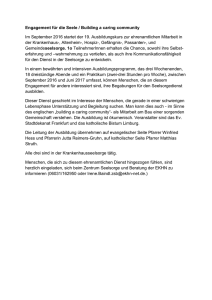
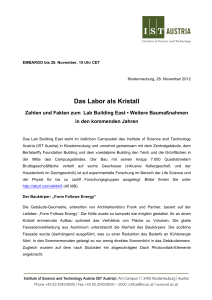
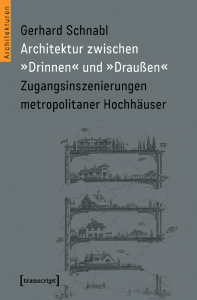
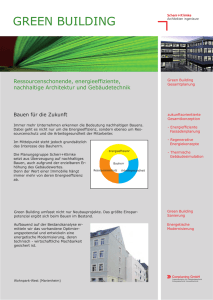
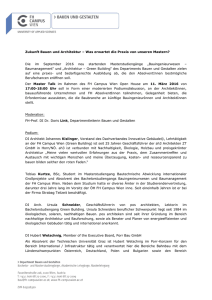
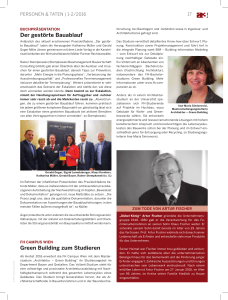
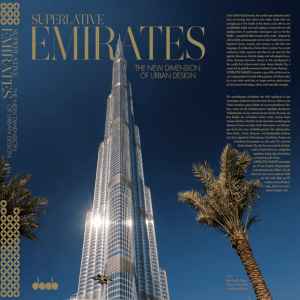
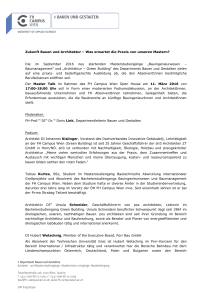
![die architektur [] - Alte Universität Graz](http://s1.studylibde.com/store/data/008186098_1-c51ac2829ba5fdf4e4250ceee219a1ea-300x300.png)
